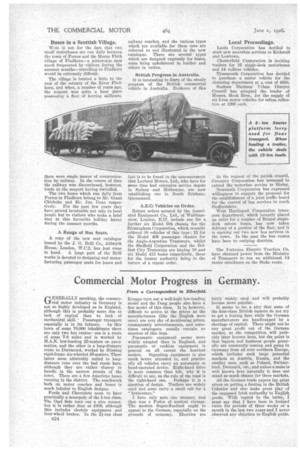Commercial Motor Progress in Germany.
Page 38

If you've noticed an error in this article please click here to report it so we can fix it.
From a Correspondent in Elberfeld.
GENERALLY speaking, the commercial motor industry in Germany is not so highly developed as in England, although this is probably more due to lack of capital than to lack of mechanical skill. Passenger transport
especially is in its infancy. In this town of some 70,000 inhabitants there are only two bus routes: one is a route of some 7-8 miles and is worked by M.A.N. low-loading 25-seaters on pneumatics, and the other is a long-distance route to Dortmund, worked by Biassing rigid-frame six-wheeled 30-seaters. These latter seem admirably suited to longdistance runs over the bad roads here, although they are rather clumsy to handle in the narrow Streets of the town. There are a few American buses running in the district. The coachwork both on motor coaches and buses is much inferior to English designs.
Fords and Chevrolets seem to have practically a monopoly of the 1-ton class. The Opel firm turn out a nice tanner, but it is rather dear at £300, although this includes electric equipment and four-wheel brakes. In the 21-ton class B24 Krupps turn out a well-built low-loading model and the Daag people also have a fine model of this class. It is, however, difficult to arrive at the prices as the manufacturers (like the English were once) are very shy of mentioning prices, consequently advertisements, and sometimes catalogues, usually contain no mention of this item.
Pneumatic equipment seems more widely adopted than in England, andpneumatic or cushion equipment is general on all except the heaviest models. Signalling equipment is also much better attended to, and practically all vehicles carry an automatic or hand-operated device. Right-hand drive is more common than left, why it is difficult to say, as the rule of the road is
the right-hand one. Perhaps it is a question of design. Trailers are widely used and some carry, a small cab for a " brakesman."
I have only seen one steamer, and that was a Forlen of ancient vintage. The modern Super-Sentinel ought to appeal to the German, especially on the grounds of economy. Eleetrics are fairly widely used and will probably become more popular.
It seems to me a pity that some of the first-class British makers do not try to get a footing here while the German manufacturers are handicapped by a shortage of capital. There might not be any great profit out of the German market, as the competition will probably later become keen, but the point is that buyers and business people generally are constantly coming and going in Germany from all over northern Europe, which includes such large potential markets as Austria, Russia, and the smaller ones, such as Poland, Switzerland. Denmark, etc., and unless a make is well known here naturally it does not stand as much chance for these markets.
All the German trade papers lay great stress on getting a footing in the British Colonies and also make great play of the supposed Irish antipathy to English goods. "With regard to the latter, I must say that I have been in Ireland twice for periods of three weeks or a month in the last two years and I never observed any objection to English goods.


























































